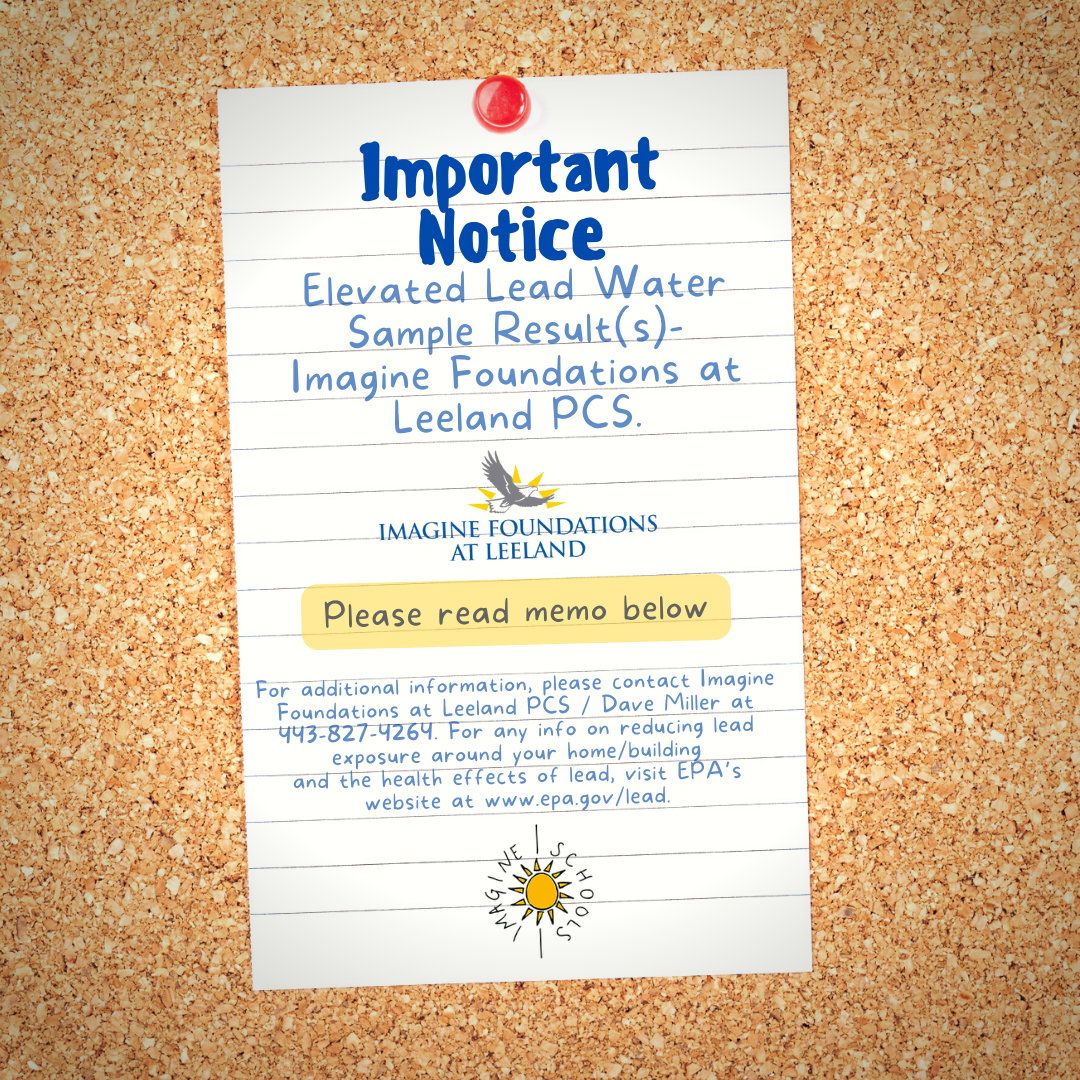
Lead in Drinking Water – Public and Nonpublic Schools
Updated in response to legislation effective as of June 1, 2021
IMPORTANT NOTICE: ELEVATED LEAD WATER SAMPLE RESULT(S)
Imagine Foundations at Leeland PCS
ELEVATED LEAD WATER SAMPLE RESULT(S)
All Maryland public and nonpublic schools are required to sample all drinking water outlets for the presence of lead pursuant to the Code of Maryland Regulations. On May 24th, 2023, fifteen lead water samples were collected from Imagine Foundations at Leeland PCS. Of these lead water samples, ONE had levels of lead exceeding the State’s revised action level of 5 parts per billion (ppb) (formerly 20 ppb; 5 ppb effective June 1, 2021) for lead in drinking water in school buildings. The elevated lead results from the sample(s) collected at Imagine Foundations at Leeland PCS were as follows: 8.3 parts per billion (ppb) Faucet in Science Lab Prep Room/Area between Classrooms 1 and 2
ACTION LEVEL (AL)
Effective June 1, 2021, the State’s AL for lead in drinking water samples collected from outlets in school buildings has been lowered to 5 ppb. The AL is the concentration of lead which, if exceeded, triggers required remediation of drinking water outlets.
HEALTH EFFECTS OF LEAD
Lead can cause serious health problems if too much enters your body from drinking water or other sources. It can cause damage to the brain and kidneys and can interfere with the production of red blood cells that carry oxygen to all parts of your body. The greatest risk of lead exposure is to infants, young children, and pregnant women. Lead is stored in the bones, and it can be released later in life. During pregnancy, the fetus receives lead from the mother’s bones, which may affect brain development. Scientists have linked the effects of lead on the brain with lowered IQ in children. Adults with kidney problems and high blood pressure can be affected by low levels of lead more than healthy adults.
SOURCES OF HUMAN EXPOSURE TO LEAD
There are many different sources of human exposure to lead. These sources include lead-based paint, lead-contaminated dust or soil, some plumbing materials, certain types of pottery, pewter, brass fixtures, food, and cosmetics, exposure in the workplace and exposure from certain hobbies, brass faucets, fittings, and valves. According to the Environmental Protection Agency (EPA), 10 to 20 percent of a person’s potential exposure to lead may come from drinking water, while for an infant consuming formula mixed with lead-containing water this may increase to 40 to 60 percent.
IMMEDIATE ACTIONS TAKEN
Within 24 hours of receiving the results the water to this device was turned off. Do not drink signage was placed and staff were notified that the water from this device is for hand washing only and no longer intended for consumption.
NEXT STEPS
This device’s designation has been changed from consumption to non-consumption. The required “Do not drink” signage was placed near the device to remind users that it is no longer a consumable device. No further action is needed.
TO REDUCE EXPOSURE TO LEAD IN DRINKING WATER:
1. Run your water to flush out lead: If water hasn’t been used for several hours, run water for 15 to 30 seconds or until it becomes cold or reaches a steady temperature before using it for drinking or cooking.
2. Use cold water for cooking and preparing baby formula: Lead from the plumbing dissolves more easily into hot water. Please note that boiling the water will not reduce lead levels.
ADDITIONAL INFORMATION
For additional information, please contact Imagine Foundations at Leeland PCS / Dave Miller at 443-827-4264. For additional information on reducing lead exposure around your home/building and the health effects of lead, visit EPA’s website at www.epa.gov/lead. If you are concerned about exposure; contact your local health department or healthcare provider to find out how you can get your child tested for lead.